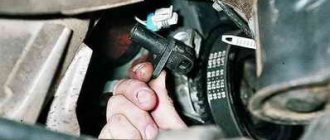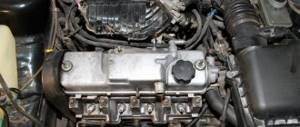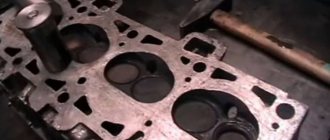The valve system of an internal combustion engine is very complex and precise. To solve a problem in the valve system, it is first necessary to diagnose its cause. Just replacing a damaged valve won't help much if the reason is that the valve guide and valve seat are misaligned. Replacing a valve that has burned out will not solve the situation if its burnout occurred due to a “hot spot” on the cylinder head. As long as the hot spot is present, the valves will continue to burn out.
- How to identify a burnt valve?
- Causes of valve burnout
- Consequences of valve burnout
- How to fix a burnt valve?
Therefore, an important point will be to analyze the causes of the breakdown before attempting repairs. A valve that has burned out or broken, worn guides, or other problems with the valve system are often the end result of a whole chain of events. One problem leads to another, which ultimately leads to valve failure.
How to identify a burnt valve?
There are several ways to check the valve for burnout. The most proven and simplest is the search for a non-working cylinder among all. To do this, you need to start the power unit. While it is idling, it is necessary to remove the caps from the spark plugs. If after this the engine changes speed, then such a power unit is faulty. And if, after removing the cap from the spark plug, you see that the engine is running as before, then the fault has affected the cylinder.
When the engine starts to stall, you should unscrew the spark plugs and swap them, or replace one of them. When you have swapped the spark plugs, start the engine immediately. If after this it starts and works normally, it means that the spark plug turned out to be working and the other cylinder stopped working.
If such a replacement turns out to be ineffective, then insert the spark plug back into the cap and put it on the engine and run it with the starter: if a spark appears, then everything is in order, but if there is no spark, then something is wrong with the slider or distributor or a fist. The very first sign of a burnt-out valve is smoke coming from the breather, which means that the spark plug is left without oil. If the piston breaks, then blue smoke will come out of the breather, and the spark plug will be covered with oil.
Valve burnout is also checked in one old way: to do this, measure the cylinder compression, this is done using a compression meter.
Then fill the cylinder with oil using a syringe and then also check the compression. If after these manipulations the compression does not rise, it means that the valve has burned out. If the compression rises, it means that a breakdown has occurred in the piston. Many motorists do not want to change a burnt-out valve, but this has a detrimental effect on engine power and fuel consumption.
Causes of valve burnout
There are many reasons for valve failure. Less often they talk about already defective factory valves, but this is the second of the main reasons for failure. The main reason is mechanical and thermal overloads.
One of the leading manufacturers of motor valves cited statistics that every fifth valve produced breaks due to manufacturing defects. The results of this study were published ten years ago. The control system has improved significantly since then, although the materials and production processes have not changed. But still, even ultra-modern quality control systems cannot provide a guarantee that the valve you have just purchased is free from any defects.
The defect may be metallurgical heterogeneity included in the alloy, which weakens the valve; forging defects leading to microcracks; pores and heat treatment errors that result in incorrect valve dimensions; poor adhesion of the chrome coating on the valve surface. Therefore, when purchasing a new valve, do the following:
– check that the valve dimensions comply with nominal standards, and that the valve is free of obvious defects;
– purchase valves only from reliable and trusted manufacturers.
All valves wear out over time. But there are those that fail much earlier than expected, and there are two reasons for this - burning and breaking. Exhaust valves often burn out due to the fact that their heating reaches significantly higher values than those of the intake valves.
The intake valves are cooled by the incoming air-fuel mixture.
The operating temperature of such valves is approximately 400°C. The exhaust valves do not have such a cooling system and, in addition, they are still heated by the flow of exhaust gases. During operation, these valves heat up to 650°C, which means they are more vulnerable to burnout and destruction. The high-temperature operating environment requires the alloy of which the valve is made to have the proper characteristics. Exhaust valves are usually made of stainless steel, both entirely and just their heads. In powerful gasoline and diesel engines, the operating temperature is even higher, so the exhaust valve is coated with a stellite coating in the form of a cobalt-based alloy, which prevents its rapid wear.
Heat is removed from the intake and exhaust valves through the guide valve and its seat. Three-quarters of the heat is dissipated through the valve seat, so it needs good contact with the seat to prevent burnout. The remaining heat is dissipated through the valve stem and is further exhausted out through the valve guide. If the valve is not regularly cooled, it will overheat and subsequently burn out.
We recommend: Valve desiccant
Anything that prevents the valve from cooling properly or creates excessive heat will cause the valve to burn out. The formation of carbon deposits on the valve and its seat prevents it from properly cooling and leads to inevitable overheating. This is also facilitated by poor contact between the valve and the seat, if it is very narrow and does not have a concentric or elliptical shape.
A spring that is too weak or a decrease in valve clearance worsens the mutual contact between the seat and the valve, which again leads to overheating. This is also facilitated by a worn seat or guide, which prevents heat transfer to the power unit.
When installing the valve, pay attention to its height. Lapped valves are located much deeper in the cylinder head than necessary. This leads to higher protruding rods, the geometry of the rocker arm is disrupted, and when the power unit heats up, the valve clearance disappears. If the required geometry is not restored after grinding down the tips of the rods, the saddles must be replaced. Another option is to install a valve with slightly larger heads that compensate for the ground seat.
Reduced valve clearance is a common cause of valve burnout. If the valve seat is worn, it moves deep into the cylinder head and reduces the clearance. As a result, the gap is completely or partially closed, and the valve does not fit well to the seat, gets very hot and subsequently burns out. This happens mainly on old engines that do not have rigid seats and are installed on heavy trucks, marine, agricultural and industrial vehicles. The way out of this situation is to install more rigid valve seats with stellite coating.
Valves can also burn out due to problems with the cooling system in the power unit itself if its operating temperature becomes extremely high. Lack of coolant, problems with the thermostat, hydraulic pump, clogged radiator, broken fan or fan switch - all this leads to overheating of the power unit. This, in turn, leads to enlargement of the valve stems, reducing the gap between the guide and the stem, which leads to the valve sticking into the guides, and it can jam. If the valve gets stuck in the open position, the piston will hit the valve, which will lead to destruction of the piston, valve and other parts.
Overheating of the valves also occurs due to greatly increased combustion temperatures. Factors such as premature or late ignition, lean fuel mixture, and detonation can play a fundamental role here. Similar reasons leading to valve overheating are exhaust obstruction caused by a clogged catalytic converter or pipe damage.
Consequences of valve burnout
If you do not replace a burnt-out valve for a long time, but continue to drive, then the first negative consequence will be high fuel consumption due to the fact that the engine is not able to produce its normal power, and the valve seat may burn out too much, as a result of which you will have to change the head.
In rare cases, a piece may break off the valve and end up in the cylinder. If this element is too large, it can pierce the head and piston. In special cases, the cylinder may also be punctured, which completely disables the power unit.
If you refuel your car with gas, then the necessary procedure will be periodic adjustment of the valves every ten thousand kilometers.
Gas burns the valves too much, especially in cases where the gas supply is set poorly. In cars that run on gas fuel, the exhaust valves are often slightly tightened. And as soon as you start adjusting the valve, it will clamp and burn out. Cars that “eat” gasoline are less susceptible to valve burnout.
Do not deliberately reduce the gas supply in order to save money. Due to a lean gas mixture, the engine significantly loses power, and excessive gas consumption occurs more significantly, since you have to press the accelerator pedal more, plus the valves and their seats gradually burn out. If the gas mixture is adjusted correctly, the power of the power unit increases so much that the difference between driving on gasoline or gas is smoothed out. But do not forget about frequent valve adjustments when driving on gas. Often, motorists decide to adjust the valves only when noise appears, but this is only suitable for those who drive gasoline. In the case of gas, you should not wait for valve noise to appear. The valve will jam and burn out even without such obvious signs.
How to fix a burnt valve?
When starting this activity, know that the first step is to remove the head from the power unit.
This procedure is performed precisely in cases with a burnt-out valve, when it absolutely does not hold, and the engine begins to stall. Valves of any format are the same, there are differences in size and placement in the head. The lapping is the same everywhere.
You will first need to purchase lapping powder. Dilute its dry composition with machine oil, or the same one you pour into the engine. Pour the powder into a previously prepared container, add oil until you obtain a porridge-like mass of medium thickness. Be sure to prepare a new gasket that you will place under the head, as well as valve seals. Often it is the exhaust valves that burn out. There are many reasons - the valve is jammed, there is a lean mixture (when the unit operates on gas), the guide bushings are significantly worn out, the valve stem is worn out.
We recommend: Which is better, a turbocharged or naturally aspirated engine?
The carburetor does not need to be removed, nor does the manifold from the head. First, desiccate the valve. Place the head on a flat surface, preferably on a table or wooden board. Place a rubber mat under the valve. You will need a tube with an internal diameter of over 13 mm. Place a tube on the valve so that the crackers are inside. Then strike with a hammer. In this case, the valve desiccates, and the crackers remain in the tube. The valve can now be pulled out.
Mount the new element by gently shaking it. A runout of up to a millimeter is considered normal - the guide sleeve can be left in place. Then try to replace the guide; here you will need a special mandrel. If you decide to knock out a part, work from the inside, towards the camshaft. Here you will need a heavy hammer and a half sledgehammer. The blow should be confident and heavy. If you use a light tool, the bushing will crumble.
Try to drive this valve bushing into the head. The sleeve should easily fit onto the valve - when it hits the head, the element is compressed. First, put on the retaining ring removed from the old bushing and lubricate the assembly with oil. Drive the bushing into the hole in the valve head until it reaches the retaining ring. Proceed carefully, as the structure is quite fragile. Do not strike the valve seal area. You can put the tube on and place it on the sleeve, protecting the parts. Place a piece of tin, a piece of wood on the edge of the bushings, place a bolt and carefully hammer it into the head. After deforming the edge of the bushing hole, make alignment using a drill and a file.
Subscribe to our feeds on social networks such as Facebook, Vkontakte, Instagram, Pinterest, Yandex Zen, Twitter and Telegram: all the most interesting automotive events collected in one place.
Why do valves burn out?
Any rubbing part of a car wears out over time. As for the valves, it is the exhaust valves that burn out more often, since, unlike the intake valves, they are not cooled by the air flow, heat up to 650°C and are more vulnerable to burnout. In them, the main heat removal occurs through the seats and guides, which means that good contact of the part with the seat is very important. The main reasons for valve burnout are the following:
- The appearance of carbon deposits on the valve and seat, creating additional heating.
- Worn valve seat or guide, which prevents complete heat dissipation.
- Violation of the valve seating height after lapping, due to which its rod sticks out higher and disrupts the geometry of the rocker arm, and when heated, the required clearance disappears.
- Underestimation of the permissible valve clearance and wear of the seat, as a result of which, after heating, the valve does not press well against the seat, allows gases to pass through, overheats and burns out.
- Engine overheating due to a breakdown of the cooling system.
- Increased fuel combustion temperature due to late or early ignition, or engine operation on a lean mixture.
- Difficult exhaust due to clogged catalytic converter or damaged exhaust manifold.
Causes of valve burnout and problem solving
The meaning of the word laquoturn
Valve burnout is the formation of a crack or melting of the valve edge. This problem can be identified by several signs. If the car owner observes characteristic symptoms, then he should contact a car service center without wasting time. If this is not done and the cause of the burnout is not eliminated, extremely unpleasant consequences may occur.
The following symptoms of valve burnout are identified, which signal to the driver that it is time to do diagnostics and repairs:
- the engine runs unstably (troits);
- loss of power, throttle response;
- Popping noises may be observed both in the exhaust system (muffler) and in the suction manifold.
Why do valves burn out?
The cause of valve burnout is usually one of the following problems:
- incorrectly adjusted thermal clearance of the valves;
- low-quality gasoline or non-compliance with the recommended octane number of fuel;
- the entry of scale or metal particles through the air and its adhesion to the valve seat or the adjacent edge of the valve;
- excess fuel;
- the appearance of carbon deposits on the valve due to hardened or torn valve stem seals, which leads to the leakage of oil, which eventually burns on the valve and is baked, which prevents the valve from cooling during its opening;
- wear of the valve guide;
- weakening of the required elasticity of the valve spring;
- valve seat damage or wear;
- malfunctions in the engine cooling system, which leads to an increase in temperature;
- failed hydraulic compensator;
- wear of cylinder rings.
Solution
When the car owner was able to find out that the valve had burned out and determined the cause of what was happening, it was necessary to proceed to repairs.
First, you need to replace the burnt valve with a new one, grind it in, and, if necessary, replace the guide sleeve and oil seal.
It is also necessary to eliminate the cause of the burnout, otherwise the problem will quickly return with further use of the car.
On some engines, the clearance is adjusted automatically using hydraulic compensators. But if the hydraulic compensator fails, the valve may burn out.
In this case, after replacing the valve, the hydraulic compensator is also changed or repaired. Only dismountable hydraulic compensators can be repaired.
If the problem is low-quality fuel, then you should get rid of it, and in the future use only high-quality gasoline
It is also important to comply with the octane number that is set by the manufacturer
If the valve spring is worn out, it must be replaced with a new one.
If malfunctions occur in the engine cooling system, leading to severe overheating and burnout of the valves, they must be eliminated.
For example, you may need to repair or flush the main radiator, replace the fan switch sensor or the fan itself, replace the thermostat, or tighten the pump drive belt.
If, while searching for an answer to the question of how to determine a burnt-out valve, wear on the cylinder rings was identified, then a major overhaul of the engine may be necessary. During this process, all excess wear and cylinder ellipse are eliminated.
How to understand that the valve has burned out
Indirect factors help determine such a nuisance. The driver should be wary of the engine running rough. This is one of the most popular signs of a burnt valve or several. It is worth considering that similar problems occur during ignition failures, so we recommend monitoring this system as well.
When a valve burns out, symptoms may include decreased power and loss of vehicle response. The car has great difficulty gaining momentum and has difficulty overtaking on the highway.
We recommend listening to the exhaust system. Engines with burnt-out valve plates periodically emit popping noises into the manifold. A characteristic sound occurs when driving or accelerating. It is not advisable to postpone repair work in such a situation.
If the gaps are adjusted poorly, this will lead to clamps. As a result, traction will decrease. Signs of pinched valves are complemented by increased fuel consumption. It is advisable to make the gap smaller than permissible rather than leaving it larger, otherwise you will soon have to replace the entire cylinder head.
The valve is burned out: signs and causes of malfunction
As you know, an engine uses a lot of complex systems. One of these is the gas distribution mechanism. Now many people are discussing the problems of a broken belt or a weakened chain. But few people mention such an element as a valve. It is this part that is responsible for the intake of the combustible mixture and the exhaust gases. One of the typical malfunctions is burnout. What are the signs of a burnt valve? More on this later in our article.
Why is this happening?
This malfunction occurs for various reasons. Moreover, even owners of new cars are not insured against valve burnout. A similar problem also exists on diesel engines. What are the signs of a burnt valve on a VAZ-2110? The usual culprit is tight saddles. All this will be accompanied by the characteristic “tractor” rumble of the engine. Valve clearances must be within specifications. If this is not the case, there is a risk of valve burnout.
A similar problem can happen on modern engines. The reason for this is non-functioning hydraulic compensators. If oil does not pass through them, the gap will be set incorrectly. Among other signs, it is worth noting an incorrectly configured HBO (if one is installed on the car). When driving with a mixture that is too lean, there is a risk of burning out one or more valves.
Why is this dangerous?
The consequences can also vary significantly, ranging from banal excessive fuel consumption to burnout of saddles. In more serious cases, damage to the piston and head occurs. How does this happen? A burnt-out exhaust valve, the signs of malfunction of which will be discussed below, is broken into small pieces. As a result, part of the “plate” enters the combustion chamber. This is how scuffs and other damage appear. Long-term use of such a car can lead to a complete replacement of the engine.
Signs of a burnt valve
On a VAZ-2110 and other cars, this malfunction will be accompanied by engine tripping. You will feel as if one of the cylinders has stopped working. Traction will also decrease significantly and fuel consumption will increase.
What to do in this case? If the valve is burnt out, signs of malfunction will be accompanied by low compression. The chamber will not generate the necessary pressure to push the piston. Therefore, first we take a compression gauge in our hands, unscrew the spark plugs and insert them into each cylinder one by one. It is worth noting that compression readings are very different on diesel and gasoline engines. In the first case, this parameter is at the level of 23-27, in the second – 10-12. But there are also exceptions. For example, on derated engines (old Soviet production, designed for 72 gasoline), this figure is 6-7 points.
It is worth noting that low compression can cause a worn cylinder-piston group. In this case, the valve will be in normal working condition. But how can you be sure that your measurements are accurate? To do this, experts recommend pouring a little oil into the cylinder through the spark plug well. Use a medical syringe. It is important that the oil corresponds to the parameters of the factory one (or what was previously filled).
After this, install a compression gauge and call an assistant to crank the starter at your command. The essence of the method is very simple - the oil, due to its viscosity, will close the cavities in the cylinder walls. This will eliminate the case of worn rings. If even with oil the compression readings are below normal, it means the valve is burnt out. The signs are obvious.
Checking the spark plugs
If you do not have the necessary oil or syringe at hand, you can determine the malfunction by the nature of wear of the spark plugs. To do this, they should be unscrewed from their seat and the condition carefully inspected. The candle will be dry, without oil deposits. Also, air or bluish smoke will come out of the engine breather. If this is a relatively new engine and signs of a burnt valve have been confirmed, then most likely you have stuck rings.
How to avoid the problem?
The main reason for burnout is the operation of the part under increased loads. The operating temperature of the valve is about 600-650 degrees. To prevent overheating, the gaps should be checked. Due to the short distance, friction occurs and, as a result, valve overheating.
Signs may also indicate poor quality fuel. On carburetor cars, the mixture is adjusted manually. It is important not to let the mixture become too lean. The same applies to cars with HBO. There are two main generations:
In the first case, the mixture is adjusted mechanically by adjusting the “greed” tap. Adjusting it is very simple - turn the tap until the car starts to stall. Next, unscrew it 1-2 turns. This is the most optimal setting. In the case of fourth-generation HBO, the configuration is done programmatically by specialists.
If the valve is burnt out, pay attention to the quality of the product when purchasing. A defective item will not last long. A high-quality valve eliminates various risks, scuffs and other defects. The part itself is inexpensive, but installation will require a fair amount of work. After all, to replace it, it is necessary to “throw off” the block head and further grind the seats.
Conclusion
So, we found out why the valve burns out. The symptoms mainly boil down to tripping - one of the cylinders will not work normally, as the mixture immediately evaporates out. To prevent re-burnout, you should properly adjust the carburetor or HBO, and also monitor the valve clearances. If a characteristic clatter is observed, it means that the gap is set incorrectly or the hydraulic compensators are clogged.
Signs that the valve is burnt out
What does a burnt valve look like?
Signs of a burnt-out valve include engine shaking, smoke from the breather (the breather is a valve for venting the crankcase and releasing excess pressure) and, when the engine operates for a long time with a burnt-out valve, increased fuel consumption. Let us explain the popular concept of “motor troit”. This means a malfunction of one cylinder, which manifests itself in a loss of power and throttle response, vibration and shots in the exhaust pipe. But these signs of a burnt out valve are ambiguous.
The engine can also stall due to broken spark plugs or a weak spark.
Smoke from the breather can also occur if the piston is damaged. But there is a distinctive feature here - the color of the smoke should be bluish, and the spark plug should be covered with oil, which is associated with a broken piston. In case of burnout, the spark plug remains dry. Note that a burnt valve in a carburetor engine and in an injector gives the same symptoms, because The only difference is the fuel injection system.
Lada Priora (2013+). Signs of burnt engine valves
Signs of a burnt-out valve include engine shaking, smoke from the breather (the breather is a valve for venting the crankcase and releasing excess pressure), and when the engine runs for a long time with a burnt-out valve, increased fuel consumption. Let us explain the popular concept of “motor troit”. This means a malfunction of one cylinder, which manifests itself in a loss of power and throttle response, vibration and shots in the exhaust pipe. But these signs of a burnt out valve are ambiguous. The engine can also stall due to broken spark plugs or a weak spark. Smoke from the breather can also occur if the piston is damaged. But there is a distinctive feature here - the color of the smoke should be bluish, and the spark plug should be covered with oil, which is associated with a broken piston. In case of burnout, the spark plug remains dry. Note that a burnt valve in a carburetor engine and in an injector gives the same symptoms, because The only difference is the fuel injection system.
Valve burnout is a common problem in gasoline and diesel engines. This malfunction occurs both on relatively “fresh” engines and on power units with an impressive mileage. At the initial stage, it is extremely important to accurately determine the nature of the malfunction, since further operation of the engine with burnt valves greatly aggravates the consequences of such a breakdown and leads to expensive repairs.
Causes of valve burnout
Valves burnout occurs for various reasons. For engines that require periodic valve adjustment, valve burnout often occurs due to untimely adjustment of the valve thermal clearance. On engines with automatic adjustment of the specified gap, failure of hydraulic compensators also often leads to the valve burning out.
The main causes of engine valve burnout are:
- the valves are tightly clamped; -the valve guide is worn; - the valve stem itself is worn out; - the engine runs on a lean mixture (especially with gas equipment);
The consequences of driving with a burnt-out valve are different, ranging from increased fuel consumption to burnout of the valve seat. In some cases, a burnt valve seat leads to the need to repair the seat or even completely replace the cylinder head. A burnt-out valve can collapse at one moment, after which fragments of the valve fall into the engine cylinder. As a result, serious damage to the piston, cylinder head or cylinder head defects may occur. In the latter case, there is a risk that a large piece of the burnt valve will pierce the engine cylinder block, which is the actual destruction of not only the cylinder head and piston group, but also the cylinder block. In such a situation, prolonged operation of the engine with a burnt-out valve may lead to the need to replace the entire engine.
Signs of a burnt valve
The main sign of burnt-out valves is a noticeable tripping of the engine in different operating modes. Also, in the case of a burnt-out valve, the engine loses a lot of power and fuel consumption increases noticeably. A certain difficulty in diagnosing burnt-out valves without disassembling the engine and removing the cylinder head is that the engine can trip for various reasons:
- wear of the CPG, decreased compression in the cylinders; - problems with spark plugs, malfunctions of high-voltage wires, etc.; - malfunctions in the engine power supply system, malfunction of injection nozzles;
What to do if the valve burns out?
In the case of burnt valves, repair consists not only of replacing them, but also of finding out the cause of the burnout. Therefore, the ignition and cooling systems should be checked. If you have replaced and ground in one valve, take the time to ground in the rest. You can replace the valve not only at a service station, but also in a garage if you are familiar with the basics of repair. Thus, the valve is an important part of the engine, so in order to protect yourself from repairs, it is better to carry out routine maintenance on time.
Determining valve burnout without removing the cylinder head
The first step is to determine which cylinder is not working. The testing methods are in many ways similar to diagnosing faulty spark plugs. To check, you should start the engine, after which, with the engine running at idle speed, you will need to remove the caps from the spark plugs one by one.
After removing each spark plug cap, you need to carefully monitor the idle speed and the overall stability of the engine. If the engine starts to rev more strongly or stall, then the cylinder from which the cap was removed is working. If after removing the cap the engine operation does not change or the speed changes only slightly, then the problem cylinder has been detected. Then you need to unscrew the spark plug on the inoperative cylinder and replace it with a known good one, and also check the high-voltage armored wire of this cylinder for functionality. It would also be a good idea to check the ignition coil, etc. Subsequent starting of the engine will show whether the problem lies in the elements of the vehicle’s ignition system or whether further diagnostics are necessary.
If the nature of the engine’s operation does not change after installing the working spark plug, replacing the high-voltage wire and checking other components of the ignition system (the engine continues to rev), then there is a high probability of more serious breakdowns:
- burnout of the timing valve; - malfunction of the CPG;
Burnout of the valves means that compression in the cylinder is reduced due to a violation of the tightness of the combustion chamber (leakage during the fit of the intake or exhaust valve, destruction of the disc and/or valve seat). Wear of the cylinder-piston group and piston breakage also lead to low compression in the problem cylinder. Also, the cylinder may not work due to stuck or broken piston rings.
Now it is necessary to localize the malfunction, that is, to accurately determine the burnout of the valve or identify problems with the CPG. The most common way to determine burnt valves is to measure the compression in the cylinders. Low compression clearly indicates a malfunction, but one caveat should be taken into account. It will not be possible to establish a burnt-out valve and rule out problems with the CPG only based on the compression indicator. The fact is that compression in the engine can decrease both as a result of a burnt-out valve, and due to broken piston rings, as well as a number of other defects. For this reason, in parallel with the compression measurement, additional engine diagnostics should be carried out.
The easiest way to determine valve burnout after you have measured the compression in the cylinders is to pour several “cubes” of engine oil through the spark plug well. Then the compression must be measured again. An increase in compression in the cylinder after adding oil will indicate that an oil film has formed, acting as a “seal”. This phenomenon is typical in the case of piston wear. If the compression indicator has not changed, it means that the valve has burned out, since the oil in the cylinder in this case will not affect the compression in any way. Also, to determine whether the valves are burned out, you should inspect the spark plug on the problem cylinder. A clear sign of valve burnout is that the spark plug is completely dry, that is, it does not have a characteristic oil deposit. There may also be smoke or air coming out of the engine breather. The intensity of smoke production directly depends on the degree of wear of the CPG. As for breakdowns that are associated with the piston, in this case the spark plug is covered with oil, and the appearance of bluish smoke can be observed from the breather. Note that oil on a candle is an indirect sign. Even if the spark plug is dry or covered with a slight soot, but smoke comes from the breather, then this symptom indicates problems with the piston or piston rings. On new engines with low mileage, there is a high probability that the piston rings are stuck.
Let us add that the appearance of engine oil that comes out through the breather also indicates a malfunction of the partitions between the piston rings. Taking into account the above, you can accurately determine why the compression in the engine has decreased, identify problems with the cylinder-piston group, or determine burnout of the timing valves.
Consequences of valve burnout
If you do not change a burnt-out valve for a long time, but drive, then the first thing that happens is high fuel consumption, since the engine does not produce its normal power, and the worst thing is that the valve seat begins to burn out, the valve seat can burn out so badly that you will have to change the head, or remove the head to a specialized workshop to replace the valve seat. Rarely, but it can happen, a piece of the valve breaks off and falls into the cylinder; if a large piece, it will damage the piston and severely break the head; if a small piece, it will break the head and piston. I saw an engine when the entire valve head flew off and broke the piston, the head (that’s half the trouble), but it also punctured a cylinder in the block of a VAZ engine (Khan’s engine) due to a defective new valve.
Valves burn out for various reasons, the valve was pinched, a very lean fuel mixture (especially if the engine runs on gas), a lot of wear on the valve guide (the valve hangs loosely in the guide), or wear on the valve stem itself (abrasion of the valve stem).
If you drive on gas, it is advisable to adjust the valves every 10 thousand kilometers; gas burns the valves very badly, especially if the gas supply is set very poorly. I noticed that when adjusting the valves, those cars that run on gas almost always have the exhaust valves slightly tightened (not yet tightened, but the feeler gauge no longer goes through), and as soon as you start adjusting the valves, the valve will definitely tighten and burn out. And those cars that run on gasoline are less susceptible to valve burnout.
Don’t try to deplete the gas supply in an attempt to save money; due to a lean mixture, the engine loses power and, on the contrary, there is excessive gas consumption since you have to put more pressure on the gas pedal, plus the valves and valve seats burn out. When the gas is adjusted correctly, the engine power increases and there is no difference when driving on gasoline or gas. But do not forget to adjust the valves more often when driving on gas. Usually they come to adjust the valves when valve noise appears, but this is suitable for those who drive on gasoline; when driving on gas, do not wait for valve noise to appear, most likely it will not appear, and the valve will jam and burn out.
content .. 94 95 96 97 ..
Why do valves burn out?
What does a burnt valve look like?
Experts identify a number of reasons why valves in internal combustion engines burn out. The most common and widespread of them are the following:
- Factory defects of the parts themselves;
- Incorrect adjustment;
- Malfunctions of the cooling system of power units;
- Malfunctions and wear of other parts of the gas distribution system;
- Long-term engine operation on a lean fuel mixture.
We recommend: How to check current leakage on a car with a multimeter
Not long ago, one of the companies specializing in the production of automotive components provided statistics indicating that approximately 20% of failed valves are caused by manufacturing defects. Nowadays, many companies are engaged in the production of these parts, and among them there are those that do not fully comply with the technology of their manufacture. Valves from these manufacturers most often burn out. As for the defects due to which they fail, they are the heterogeneity of the metal; defects that appear during forging and improper heat treatment; microcracks; poor adhesion of the valve surface coating.
A fairly common cause of valve burnout is improper adjustment of their thermal clearances. It leads to overheating of parts with all the ensuing consequences. It should be noted that for this reason, valves burn out both in engines in which they are adjusted manually and in those in which this process is carried out automatically. In the second case, hydraulic compensators are responsible for adjusting the thermal gap, and if for some reason they fail, the valves begin to overheat.
Their temperature can also rise excessively in cases where the engine is poorly cooled. This may occur due to problems with the pump, thermostat, clogged radiator, or a simple lack of coolant.
It often happens that during long-term operation of the engine, the valve guides wear out. This, as well as such a defect as weakening of the elasticity of the clamping spring, often leads to incorrect positioning of the part and, as a consequence, its overheating and burnout. In addition, valves often burn out when engines run on a lean fuel mixture for a long time.
How to find out whether the problem is in the CPG or in the valve?
First, start the engine and remove the breather hose. If the problem is with the CPG, then the smoke from the hose will be dense and gray and the smell will be similar to the exhaust. If the engine is working properly, only warm air should come out of the hose;
— even if the problem is in the CPG, you still need to unscrew the spark plug from the non-working cylinder and look at its condition. If the piston is damaged, the spark plug will be in oil. If the problem is a burnt-out valve, then the spark plug will be in normal working condition. By the way, we can tell you a lot about the condition of the candle.
When you are already convinced of what exactly the problem is and who the “culprit” is, you will need to dismantle the cylinder head and replace the corresponding part. When replacing a valve or valves during the repair process, do not forget about grinding them in. It would also be a good idea to replace the valve stem seals. Here are some simple tips for identifying a burnt-out valve and, in general, everything that I wanted to tell you about the question of why valves burn out. As you can see, there is nothing complicated. The main thing is not to immediately rush to extremes and not start disassembling the engine without performing the most basic diagnostics and without fully finding out the reason why this or that problem arose. Good luck with your repairs!
Proinomarki.ru
Replacing burnt out valves
The operation of replacing the valves of different engines is similar, and differs only in the size of the parts and their placement on the cylinder head. Before performing the operation, prepare lapping powder, new valve seals and a new head gasket. After dismantling the cylinder head, operations are performed in the following order:
1. Valve desiccation. To do this, the head is laid out on a flat surface and a rubber mat is placed under the valve. A tube with a diameter of 13 mm is placed on the valve so that the crackers are inside, and blows are applied with a hammer. The valve desiccates, and the crackers remain in the tube. The operation is also easily carried out using a special device that compresses the vein and allows you to pull out the crackers.
- The valve is pulled out, a new one is inserted, and the bushing guide is checked by shaking. If runout is up to 1 mm, the guide is not replaced.
3. If it is necessary to replace the guide, use a special mandrel. The old part is knocked out in the direction of the camshaft using a half-sledge hammer with a heavy blow so that the part does not crumble. Afterwards, a new bushing is driven into the head, having first put a retaining ring on it.
4. The new valve is secured with a retaining ring and the assembly is lubricated with oil.
5. Valve grinding. The seat is initially treated with a special cutter, after which lapping powder is applied to the edge of the valve, inserted into the head, the other end is clamped into the drill chuck, and by pulling it up and down, the valve is provided with a tight fit to the seat. It is advisable to carry out the operation for all valves.
6. Drying of the valve. To do this, press the spring firmly and insert crackers. The cylinder head is attached to the engine cylinder block.
The described method allows you to replace the burnt valves of all models of the VAZ: 2101, 2102, 2103, 2104, 2105, 2106, 2107, 2108, 2109, 21099, 2110, 2111, 2112, 2113, 2114, Niva, Lada Priora, viburnum, Grant, Grant, Grant. Vesta and most foreign cars.
What is burnout?
Metal destruction under the influence of high temperatures is typical for both diesel and gasoline engines. Even taking into account the fact that most of the important parts of the gas distribution mechanism are made of special high-strength steel grades, under certain conditions they are destroyed.
The actual combustion of the metal is not carried out in the classical form. Parts are destroyed from different sides.
It is important to know that a burnt-out valve can be identified by cracks formed on the edges or by obvious penetrations in the working surface.
Due to the fact that defects form on some coins, the tightness of the interface between the seat and the plate disappears. As a result, this results in engine problems, and can manifest itself in serious damage to the internal combustion engine.











